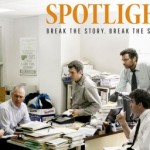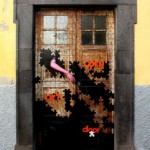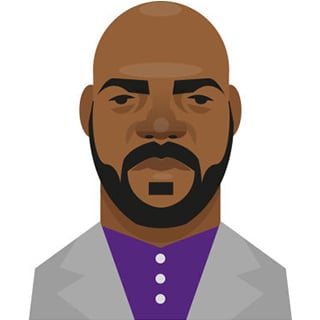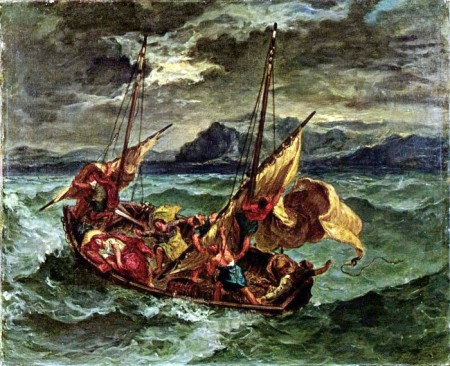 Jesus, Savior, pilot me, over life’s tempestuous sea . . . My grandmother loved this hymn, playing it over and over on the parlor piano in her house.
Jesus, Savior, pilot me, over life’s tempestuous sea . . . My grandmother loved this hymn, playing it over and over on the parlor piano in her house.
In Matthew’s version of the story, the disciples, caught in a storm at sea, fear for their lives. And then Jesus comes walking toward them, over the water, and the sea is calmed. Peter, excited as he often is, jumps out of the boat and begins walking toward Jesus – he, too, is walking on water – but the wind comes roaring back, and then Peter is afraid. Sinking, he calls Help! and Jesus touches him, and takes him to the boat, and says, Do not be afraid, you of little faith.
I spent a recent week on Cape Cod, at a writer’s retreat in Provincetown, a jewel of a town nestled into the edge of the sea. The Pilgrims first alit there, and after them, many writers and artists and fishermen like Peter, have found a haven for their work by those lapping waters. Yet recent maps of flood plains, based on climate change and patterns of recent storms, show most of Provincetown endangered, likely to be destroyed by storms in the next decades. It is hard, on a beautiful summer day, to feel fear for these sparkling seaside towns. And hard to find the courage, the faith as Jesus says, to walk in the storm of public argument that can avert this disaster.
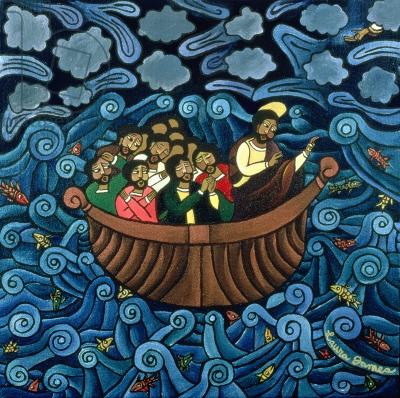 On the long list of things that warm the world, surely warfare, with its arsenal of fiery bombs, exploding mines, flaming bullets, gas guzzling machines, is a huge offender. You don’t have to be too smart to figure out that war is the wind endangering the small boat of the planet. The winds of war are driven by fear, and the experts tell us fear, a primary emotion, often expresses itself in secondary emotions such as anger, violence, hostility.
On the long list of things that warm the world, surely warfare, with its arsenal of fiery bombs, exploding mines, flaming bullets, gas guzzling machines, is a huge offender. You don’t have to be too smart to figure out that war is the wind endangering the small boat of the planet. The winds of war are driven by fear, and the experts tell us fear, a primary emotion, often expresses itself in secondary emotions such as anger, violence, hostility.
In Israel and Palestine fear runs deep in the bone. For Israel, a people driven off their land by the Roman Empire in 69 AD, people who lived in exile in Europe for the next 1900 years, learning to farm in forest towns (shetls, as in Fiddler on the Roof) in eastern Europe (what is now the Ukraine) or learning the skills of bankers and traders in western European cities where they lived in ghettoes, the experience of forced emigration was horrific. Never accepted, continually persecuted, preached against by Christians, considered sub-human, then sent to Hitler’s ovens, the survivoring Jews came out of the camps of Germany with nowhere to go, and an undying dream of going home again. The nation Israel was made possible by European and American decisions about a region of the world that was still, largely, part of European empires. The nation of Israel became a success through the work and sacrifice of millions of Jews around the world. But they remain a small boat, 6 million Jews surrounded by a sea of 1.5 billion Moslems.
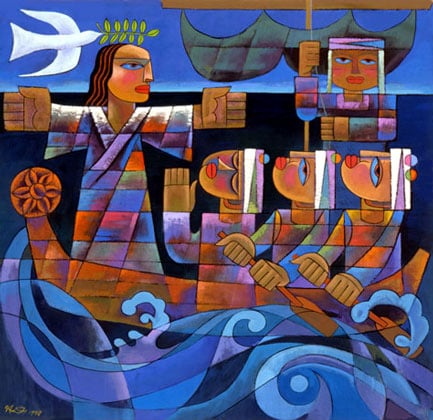 For the same 1900 plus years, Arab people have lived in the land which is now Israel. Rural, poor, and without life skills for a modern world, the 700,000 Arabs who were removed from the land which is now Israel became the political losers Jews had been in Europe, restricted outside Israel, or, if they chose to stay, having very few citizenship rights in a nation which, by its Constitution, is for Jews. Acts of violence and periodic outbreaks of war sharpen the hatred between peoples who have nowhere else to go, who live with existential fear every day, who bear scars from their long histories of humiliation, and whose hearts are full of outrage.
For the same 1900 plus years, Arab people have lived in the land which is now Israel. Rural, poor, and without life skills for a modern world, the 700,000 Arabs who were removed from the land which is now Israel became the political losers Jews had been in Europe, restricted outside Israel, or, if they chose to stay, having very few citizenship rights in a nation which, by its Constitution, is for Jews. Acts of violence and periodic outbreaks of war sharpen the hatred between peoples who have nowhere else to go, who live with existential fear every day, who bear scars from their long histories of humiliation, and whose hearts are full of outrage.
There is so much religion in this, and yet, where is faith? The howling winds of arguments, for warfare as a basic right and political need, are not manifestations of what it means to be human, which Judaism, Islam, and Christianity are fundamentally about. And the winds of these arguments are global. Putting trust in Yahweh, Allah, God, rather than in guns and armies, is not a choice the fear inside us wants us to make.
In Israel, the establishment of a state religion has engendered cumbersome definitions of who really is 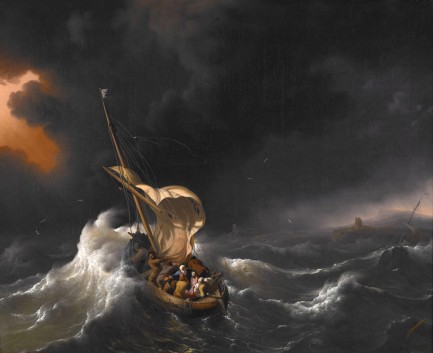 a Jew, arguments which alienate many. Palestine, home of many Moslems, also contains a Christian Arab population, people not happy about cries for Moslem nationalism. Many Jews and Arabs have European blood in their veins. Many Jews and Arabs, as well as Christians, are now secular people. Our world is increasingly heterogeneous, interbred and intermarried. Intermarriage and interbreeding are practices that trace back to Abraham and recur throughout the Bible. Jesus’ own paternity is up for question.
a Jew, arguments which alienate many. Palestine, home of many Moslems, also contains a Christian Arab population, people not happy about cries for Moslem nationalism. Many Jews and Arabs have European blood in their veins. Many Jews and Arabs, as well as Christians, are now secular people. Our world is increasingly heterogeneous, interbred and intermarried. Intermarriage and interbreeding are practices that trace back to Abraham and recur throughout the Bible. Jesus’ own paternity is up for question.
We are left with critical questions: who really are the people of God? who really qualify? The answer concerns spiritual borders as well as ethnic, religious and territorial borders. The questions apply to American and European borders as much as to the border of Gaza. The world is getting so much smaller. And we all belong in the one boat, Earth.
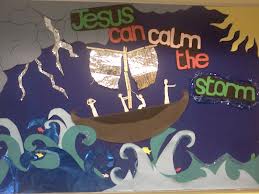 Border wars, over culture, understanding, and acceptability, are fought everywhere in these days. Border wars are fought around hymns, instruments on which they may be played, the language of prayers, gender pronouns for God, and the human experience of love (is it only for the married? the straight? is it allowed between races? between nations?)
Border wars, over culture, understanding, and acceptability, are fought everywhere in these days. Border wars are fought around hymns, instruments on which they may be played, the language of prayers, gender pronouns for God, and the human experience of love (is it only for the married? the straight? is it allowed between races? between nations?)
Fear is a formidable power. And fear’s agenda has nothing to do with hope, love, peace, faith, forgiveness, all those welcoming spirits that occupy the world of God. In our willingness to serve fear’s agenda, much that is God’s in this world may be drowned. And in our willingness to ignore love’s agenda, we may evolve into beings far less human than we have ever been. The Garden, Earth, which suffers greatly from our carbon emissions, cannot sustain our wars over turf, our pride in weaponry, our love of bigger and bigger fantasy weapons.
Unknown waves before me roll, hiding rock and treacherous shoal.
Chart and compass ever be. Jesus, Savior, pilot me.
__________________________________________________________
Illustrations:
1. Christ and the Disciples in a Raging Storm. 1854. Eugene Delacroix, Walter Art Museum, Baltimore, Md. Vanderbilt Divinity School Library, Art in the Christian Tradition.
2. Calming the Storm, from a book cover, Introducing the New Testament, by Mark Allan Powell.
3. Calming the Storm. He Qi. 2000. Nanjing China. Vanderbilt Divinity School Library, Art in the Christian Tradition.
4. Christ in the Storm on the Sea of Galilee. 1695, Backhuysen, Ludolf . Vanderbilt Divinity School Library, Art in the Christian Tradition.
6. Jesus Can Calm the Storm. Child’s drawing, Google Images.


